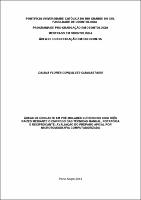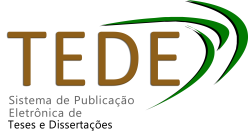| Share record |


|
Please use this identifier to cite or link to this item:
https://tede2.pucrs.br/tede2/handle/tede/1247| Document type: | Dissertação |
| Title: | Áreas de desgaste em pré-molares superiores com três raízes mediante o emprego das técnicas manual, rotatória e reciprocante : avaliação do preparo apical por microtomografia computadorizada |
| Author: | Giannastasio, Daiana Flores Gonçalves  |
| Advisor: | Pelisser, Fabiana Vieira Vier |
| Abstract (native): | Introdução: Este estudo avaliou, in vitro, através da microtomografia computadorizada (μTC), as áreas de desgaste em canais radiculares de pré-molares superiores com três raízes, causadas por três diferentes sistemas de preparo. Métodos: Após a abertura coronária, esvaziamento dos canais e estabelecimento da odontometria a 1,5 mm do vértice radiográfico, dezoito espécimes foram divididos em três grupos, de acordo com a técnica de preparo empregada para o preparo do canal radicular: Grupo manual (Hand) (n=6) - os dentes foram preparados manualmente pela técnica coroa-ápice, com limas de aço-inoxidável flexíveis; Grupo ProTaper (GPt) (n=6) dentes preparados pelo sistema rotatório ProTaper e Grupo WaveOne (GWO) (n=6) - dentes preparados pelo sistema reciprocante WaveOne. Os alargamentos apicais finais nos canais mésio-vestibular (MV), disto-vestibular (DV) e palatino (P) corresponderam a 0,25 mm, 0,25 mm e 0,40 mm, respectivamente. Os dentes foram microtomografados antes e após o preparo dos canais. As imagens pré e pós-operatórias, correspondentes a 0, 2, 4, 6 mm do batente apical, foram sobrepostas e a diferença entre as áreas dos canais cirúrgico e anatômico foram mensuradas, com o auxílio do programa PhotoShop. Os grupos foram comparados estatisticamente, empregando-se Anova de Dois Critérios e Post-hoc de Tukey (P<0,05). Resultados: Não houve diferença entre as técnicas de preparo (P<0,05). Independente da técnica empregada, percebeu-se um maior alargamento em direção a porção mais cervical do canal. Alguns canais apresentaram alargamento excessivo porém, não houve perfuração. Por outro lado, em algumas raízes observou-se áreas não tocadas. Conclusão: Não houve diferença entre as técnicas manual, rotatória e reciprocante, empregadas para o preparo apical de pré-molares com três raízes. Todas são seguras para o preparo do terço apical desses dentes. |
| Abstract (english): | Introduction: The aim of the present study was to evaluate the apical enlargement areas of three-rooted human upper premolars by means of micro-computed tomography-(μCT). Métodos: After the cavity access, canal exploration and odontometry, eighteen samples were divided into three groups according to the preparation technique: manual group (Hand) (n=6) teeth were instrumented by crown-down technique and stainless steel files; ProTaper group (GPt) (n=6) teeth were instrumented by using the Rotary movement and ProTaper system; and WaveOne group (GWO) (n=6) teeth were instrumented by WaveOne instrument operated in reciprocating movement. The final canal enlargement at mesiobuccal (MB), distobucal (DB) and palatal (P) roots match 0,25 mm, 0,25 mm and 0,40 mm, respectively. Micro-computed tomography-(μCT) was performed before and after preparation. The pre and post images corresponding to 0, 2, 4 and 6 mm from the apical stop were overlaid and the difference between the areas of surgical and anatomical canals were measured with the aid of PhotoShop program. The groups were statistically compared using two-way Analysis of Variance (ANOVA) and Tukey post-hoc test at 5% significance level. Results: There was no difference between the preparation techniques. Regardless of the technique, we found further enlargement toward the cervical portion of the canal. Some canals had excessive enlargement, but no perforation. Moreover, untouched areas were observed in some roots. Conclusion: There were no differences in all roots when comparing hand, rotary and reciprocating techniques. All of them are safe for the instrumentation of the apical third of three-rooted premolars. |
| Keywords: | ODONTOLOGIA ENDODONTIA CANAL RADICULAR TOMOGRAFIA COMPUTADORIZADA |
| CNPQ Knowledge Areas: | CNPQ::CIENCIAS DA SAUDE::ODONTOLOGIA |
| Language: | por |
| Country: | BR |
| Publisher: | Pontifícia Universidade Católica do Rio Grande do Sul |
| Institution Acronym: | PUCRS |
| Department: | Faculdade de Odontologia |
| Program: | Programa de Pós-Graduação em Odontologia |
| Citation: | GIANNASTASIO, Daiana Flores Gonçalves. Áreas de desgaste em pré-molares superiores com três raízes mediante o emprego das técnicas manual, rotatória e reciprocante : avaliação do preparo apical por microtomografia computadorizada. 2014. 43 f. Dissertação (Mestrado em Odontologia) - Pontifícia Universidade Católica do Rio Grande do Sul, Porto Alegre, 2014. |
| Access type: | Acesso Aberto |
| URI: | http://tede2.pucrs.br/tede2/handle/tede/1247 |
| Issue Date: | 27-Feb-2014 |
| Appears in Collections: | Programa de Pós-Graduação em Odontologia |
Files in This Item:
| File | Description | Size | Format | |
|---|---|---|---|---|
| 458210.pdf | Texto Completo | 1.12 MB | Adobe PDF |  Download/Open Preview |
Items in DSpace are protected by copyright, with all rights reserved, unless otherwise indicated.




